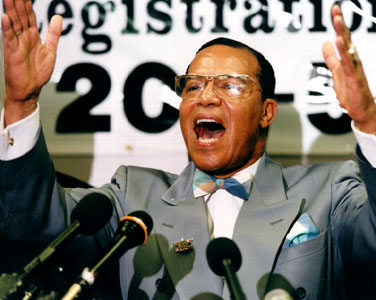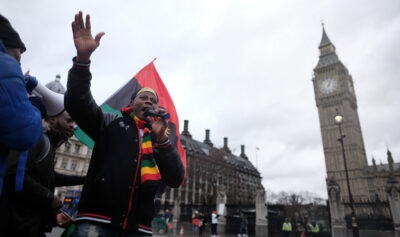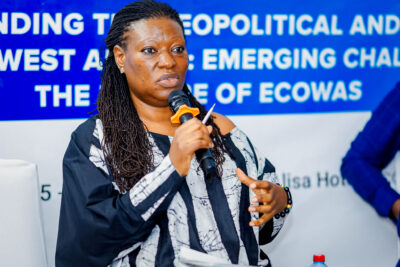 In 1963, historian Robert Payne penned a lengthy article for The New York Times Magazine entitled “Why 400,000 Follow Mohammed.” The piece told the story of Islam’s “Arabian” origins in reverential (and highly orientalist) fashion, narrating the humble origins of the Prophet Muhammad as an orphan and “poverty-stricken youth,” and describing the God of the Qur’an as “stark, elemental, beyond all human comprehension,” an Almighty who “rides the whirlwinds, fixes the starts in their courses, penetrates into the recesses of the human heart, and all things are known to Him.”
In 1963, historian Robert Payne penned a lengthy article for The New York Times Magazine entitled “Why 400,000 Follow Mohammed.” The piece told the story of Islam’s “Arabian” origins in reverential (and highly orientalist) fashion, narrating the humble origins of the Prophet Muhammad as an orphan and “poverty-stricken youth,” and describing the God of the Qur’an as “stark, elemental, beyond all human comprehension,” an Almighty who “rides the whirlwinds, fixes the starts in their courses, penetrates into the recesses of the human heart, and all things are known to Him.”
The central impetus for Payne’s essay, however, was not to introduce an unfamiliar religion to the American public but to clarify the “truth” of Islam’s Sunni orthodoxy in the face of “the rise of the black Muslim sect” in the U.S. The teachings of the black Muslims of the Nation of Islam, under the leadership of Elijah Muhammad, the author emphasized, “are directly opposed to the teachings of Islam”—in particular, their stance on “race hatred” against whites. Payne closed the piece by unequivocally placing the NOI and its adherents beyond the pale of an authentic Islam, saying that the organization’s beliefs were “unthinkable” to “the true Moslem” (italics added).
In the almost half-century since, the Times appears to have done little to shift the Good (Orthodox) Muslim-Bad (Black) Muslim paradigm asserted in Payne’s article, which paints stark dividing lines between the “good” racial universalism of a “global” Sunni Islam and the “bad” racialized parochialisms of the NOI, and of African American Islam more broadly. Indeed, this very same logic was at the heart of David Lepeska’s April 10 article regarding current NOI leader Louis Farrakhan’s recent support of Colonel Muammar el-Qaddafi. Leading with the unsubstantiated claim that Farrakhan was championing Qaddafi to bolster the dwindling ranks of his organization, Lepeska stated that the NOI had lost its appeal in black America, and that African American converts were now more “likely to join traditional sects led by Arab and South Asian immigrants.” Like Payne five decades ago, Lepeska and the Times found it necessary to situate black Muslims beyond the pale of Islamic orthodoxy, this time via a quote from Islamic studies scholar Ihsan Bagby, who stated, categorically: “The theology of the Nation contradicts the basic tenets of Islam.”
In his response to Lepeska’s piece, Edward Curtis aptly addresses many of the article’s shortcomings, pointing out the sharp racial divisions between black, Arab, and South Asian communities in the nation’s mosques, and thus contradicting Lepeska’s notion that most African American Muslims join through immigrant congregations. In addition, he contextualizes Farrakhan’s support of Qaddafi within a long history of Pan-Africanist politics and activism, which have always been at the heart of African American Islam, thus refuting the idea that Farrakhan is suddenly pandering to the black masses to regain his limelight (as well as the almost laughable notion that support of Qaddafi would somehow galvanize black Americans to join the NOI). Finally, he rightfully emphasizes how the NOI has always been, not simply a political, but a deeply religious organization and criticizes the media’s attempts to “shape and constrain what constitutes legitimate Islam.”
As a scholar who studies the intersections of race and Islam in the contemporary U.S. cultural imaginary, my concern with media narratives such as Payne’s and Lepeska’s is not so much how they portray the teachings of the NOI as contradictory to Islam’s Sunni orthodoxy (which they are), but how charges of the group’s lack of compliance with this orthodoxy are somehow linked to acts of racial betrayal, an equivalence used to diffuse and discredit the NOI’s (or any other offending organization’s) critiques of state-sponsored racism and/or U.S. military aggression and intervention. In the 1963 piece, the NOI’s black nationalist position is summed up as “race hatred” of whites, a stance that must be exposed as anathema, not only to the integrationist rhetoric of the civil rights movement, but to what Payne portrays as the universalist and egalitarian ethos of orthodox Sunni Islam, whose teachings, interestingly enough, dovetail nicely with the fundamental tenets of U.S. liberal democracy.
Lepeska merely updates this formula for the post-9/11 era; Farrakhan’s support of Qaddafi is dismissed as the ego-driven ranting of a fringe religious figure, as have been his criticisms of U.S. foreign policy and calls for slavery reparations over the course of the last decade. Indeed, the bulk of the article is spent discussing Farrakhan’s and the NOI’s fading relevance, as opposed to addressing the NOI leader’s specific objections to the U.S. intervention in Libya, including his concerns over our “meddling in another country’s internal affairs and calling for regime change” and his indication of America’s failure to intervene in other conflicts between a state and armed groups, such as in Israel-Palestine, or in the other democratic uprisings in the Middle East—e.g. Yemen, Egypt, Syria, etc.
It’s an interesting discursive strategy for the Times to dredge up during a time when Islamophobic rhetoric is at an all-time high, to champion the “orthodox” Islam of “traditional sects led by Arab and South Asian immigrants” in order to delegitimize the internationalist and antiracist spirit of black protest that has long been the hallmark of African American Islam. Whether Farrakhan’s teachings are legitimately “Islamic,” or whether the NOI is an “authentic” Muslim organization, is not the issue here—let’s leave that to the theologians, as opposed to a media establishment that continues to exhibit a stunning ignorance of the intertwined histories of race and Islam in America. A more productive question might be: why is the NOI’s “unorthodoxy” still news?
More than anything, the Good (Orthodox) Muslim-Bad (Black) Muslim paradigm reveals the media’s seemingly willful ignorance of the longstanding diversity of Islamic practices within black America and of the consistently worldly, heterodox, and syncretic legacies of African American Islam. The contemporary landscapes of Muslim America have been inexorably formed through processes of cultural interaction and exchange, both between black and “immigrant” Muslims and amongst various African American Islamic organizations themselves, since “Islam,” in its many forms, began its spread through African American communities in the urban landscapes of the post-Reconstruction North. Since the early twentieth century, in places like Detroit and New York, Chicago and Philadelphia, Washington D.C. and Milwaukee, both “orthodox” and “heterodox” Islamic organizations such as the Moorish Science Temple, the Ahmadiyya Movement in Islam, the NOI, Darul Islam, the Hanafis, Ansaru Allah, the Five Percent Nation, the American Society of Muslims (founded by Elijah Muhammad’s son, Warith Deen Muhammad, after he assumed leadership of the NOI, in 1975), and many others, have all been a part of the making of a distinctly African American—and thus, distinctly American—Islam. Each of these organizations, one can safely argue, has in one way or another advanced its Islamic engagements through discourses of black liberation and the spiritual quest for black humanity—what African American Sunni Muslim scholar Sherman Jackson has called the “cosmic no” of black Religion.
This “cosmic no” to the U.S. intervention in Libya was also expressed by African American Sunni Muslim leader Imam Zaid Shakir. Shakir (along with Shaikh Hamza Yusuf) is among the most prominent Muslim American leaders in the contemporary U.S. and seeks to revive in the West the “traditional” study methods and sciences of the classical Sunni tradition. (The two, along with scholar Hatem Bazian, recently founded Zatyuna College in Berkeley, which is seeking become the nation’s first accredited Islamic college.) On March 24, Shakir posted a widely-circulated essay on his blog, New Islamic Directions, entitled “Why I Oppose the US-Led Intervention in Libya.” In it, he stated that while he knew that his position “may be perceived as an unpopular one, not least because the Libyan rebels themselves called for—and have received military assistance from the West,” he nonetheless warned against the dangers of “a US-led invasion of another Muslim country,” predicting that U.S. intervention “will likely lead to far more civilian deaths than would have occurred [in] a strictly Libyan affair.” He also pointed out, as had Farrakhan, that the ouster of Qaddafi was likely a high priority for the U.S. due to how Qaddafi had long been “leading a Pan-African movement under the auspices of the African Union,” in which Libya’s oil revenues were being used toward Africa’s economic empowerment. In his concluding remarks, Shakir wrote: “I do not believe western intervention is solely motivated by humanitarian concerns, nor do I believe it will succeed. I cannot support it.”
Unsurprisingly, Shakir’s views received no coverage in the mainstream media.













Dr. Chan-Malik,
Thank you for writing the thoughtful and observant article. What you are describing here is in essence, the unheard battle cry from amongst a small but growing group of indigenous American Muslims. While this group is mostly composed of Blackamericans [such as myself], it also includes an even smaller minority of Whiteamericans who see this dichotomy of Good/non-racialized Muslim and Bad/racialized Muslim a major obstacle in the maturation process of Muslims in America.
The observations by Payne and more recently, Lepeska, continue to illustrate the unwillingness on the part of American intelligentsia [from journalists to scholars] to depart from an essentialized interpretation of Islam: no matter where Islam may go, it and Muslims, if they wish to be considered authentic [a double for your ‘orthodoxy’], then they and Islam must be connected with an innate foreignness, be it Arab or South-Asian, in order for “true Islam” to remain intact. As a scholar in the academy yourself, you must be all too familiar with this view. Just look at how Islam is studied in the Academy: if one wishes to study African-American Muslims, you are immediately relegated to the Black Studies department; if one wishes to study Arab-Americans, one can still do so under the umbrella of the Middle-Eastern studies department or something akin to this. Until the Academy also relinquishes its grasp on orthodoxy/authenticity, it will be hard to appreciate the rhetoric of the NOI in any other light than that of “race-based hatred.”
And to address that directly, there is an unwillingness to concede, on the part of immigrant Muslims as well as Blackamerican Muslims who have given up on race in the hopes of expressing a more authentic Islam, that the “cosmic no” that Dr. Sherman Jackson speaks of can, at the moment, only be effectively articulated by the practitioners of “Black Religion” [see Jackson’s Islam and the Blackamerican]. This “cosmic protest” seeks to bring white values back down to earth, removing the transcendent qualities they are unquestionably given in the modern context. Sadly, as you have noted, such attempts are perceived by journalists, scholars and even elements within the Muslim community that fear such critiques will jeopardize their commitment to an authentic Islam to be nothing other than the rhetoric of a morally bankrupt cult, whose leader is making a last-ditch effort to rejuvenate their constituents.
As a scholar who is working closely with this subject, do you see, if at all, any means of moving beyond this road block?
Dear Marc-
Thanks so much for your eloquent and thoughtful reply. As an ethnic studies scholar who studies religion, specifically Islam, one of the central contentions of my work is that we (in particular, scholars, the media, and community members themselves) have to try to understand Islam’s longstanding cultural—and deeply racialized—presence in America as deeply constitutive of current trajectories of Muslim American identity, community, and cultural formation. In other words, despite the theological arguments about what constitutes a “real” Islam, “Islam” in some form has been present in the US since the first slaves began arriving in the American from West Africa, and its racialized cultural presence—through the blues, jazz, the Black Arts movement, hip hop, etc.—has fundamentally shaped the contours of the national imaginary (both how Americans think about Islam and how Muslim Americans think about themselves). This is something that not only the media and the academic intelligentsia must acknowledge however, but a reality the Muslim American community must also engage and grapple with itself. In other words, how do we reconcile Islam in America’s constitutive blackness and the cultural legacies of this history to the inexorably multiethnic and multiracial landscape of post-9/11 America?
So I guess to (rather insufficiently) answer your question, I would say that since an American orientalist ideology that relegates an authentic Islam to South Asia and the Middle East is a deeply racialized discourse that has been actively shaped by rejecting the cultural force of Islam’s racialized (Black) historical presence in the US, Muslim American activists and thinkers and intellectuals must begin by actively reclaiming this cultural history, and actively rejecting media portrayals such as Lepeska’s that seek to reinforce these antiquated divisions. We must address the “black”-“immigrant” issues in Muslim American communities by exposing long histories of comparative racial formation(both conflict and coalition) that are crucial to understanding how such dynamics are playing our on the contemporary landscape. For me, I am also trying to create a cultural narrative of Islam’s racial presence in the US that shows scholars of race and ethnicity in the US that it is crucial for them to engage with issues of religion or spirituality to understand and fully engage with some of the most pressing issues of our time.
Again, thanks for your comment. Hope the conversation continues.
Thank you Dr. Chan-Malik for taking the time to respond. One part stood out to me, that begs recognition:
I would ask, rhetorically, how else can Islam be reconciled in America without blackness and its cultural legacy? In my opinion, there is no other “space” to which Islam can be placed in regarding the American context, where it is “safe” other than blackness. This isn’t an attempt to claim blackness as some sort of superiority to non-black expressions of Islam, but to simply recognize [and push for that recognition in the public sphere] that blackness remains to this day the only conduit by which Islam can express itself and is not seen by the broad [read “white”] public to having committed, to quote Dr. Sherman Jackson again, cultural apostasy. And under no uncertain terms, this insulation is not itself immune to falling by the waste side, as it is in danger of doing, especially as more and more Blackamerican Muslims embrace Islam through the lens of racial agonsia in this so-called post-racial America.
What I have been searching for and continue to search for is a way and method of bringing this reality [as you put it, “American orientalist ideology that relegates an authentic Islam to South Asia and the Middle East”] to the attention of Muslim and non-Muslim Americans. It is much a dilemma within the Muslim-American community as it is within American orientalist circles.
I look forward to more of your engaging work. Thank you again.